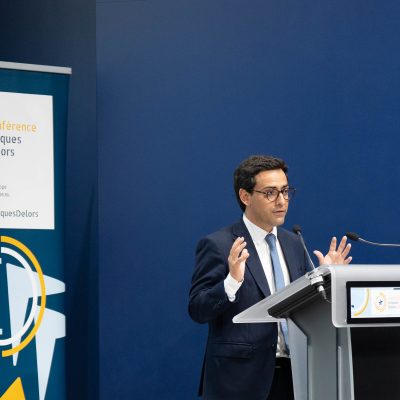Quand prendront fin les négociations du budget européen ?

Eulalia Rubio, Chercheuse senior, Institut Jacques Delors
Traduction de l’anglais par Mathilde Durand
Avec la décision du président du Conseil européen, Charles Michel, de convoquer un sommet spécial sur le budget européen le 20 février, les négociations sur le prochain cadre financier pluriannuel de l’UE entrent dans leur dernière phase. Alors qu’a commencé le sommet européen, il est intéressant de rappeler l’enjeu de ces négociations, en analysant certaines des questions les plus controversées de la négociation et en évoquant ce qui pourrait advenir lorsque le Parlement européen entrera en jeu.
De l’importance des négociations du CFP
Ces dernières années, l’Union européenne a été plongée dans un débat sans fin sur les réformes à engager. Le processus de réformes de l’UE a cependant été plutôt décevant : si les « programmes » et « feuilles de route » adoptés par les responsables européens ont été nombreux, les changements réels ont été très limités. Les négociations sur le prochain cadre financier pluriannuel (CFP) offrent une excellente opportunité de modifier considérablement les modalités de fonctionnement de l’UE et de redéfinir ses compétences. Les décisions relatives au montant et à la répartition du nouveau CFP, qui couvre une période de sept ans (2021-2027), contribueront de manière décisive à la définition des dépenses prioritaires de l’UE au cours de la prochaine décennie.
Le prochain budget communautaire pluriannuel revêt une importance particulière pour soutenir « le Programme pour l’Europe » fixé par la nouvelle présidente de la Commission. Outre d’autres priorités, celui-ci comporte un ambitieux Green Deal européen visant à parvenir à la neutralité climatique d’ici 2050. Pour atteindre cet objectif, la Commission von der Leyen s’est engagée à mobiliser, au cours de la prochaine décennie, jusqu’à 1 000 milliards d’euros supplémentaires pour des investissements liés au climat. La moitié de ces investissements doit provenir du prochain budget communautaire pluriannuel.
Le budget communautaire est par ailleurs fondamental pour relever les autres défis politiques du programme. Il existe par exemple un consensus sur la nécessité d’augmenter les investissements européens dans la recherche et l’innovation disruptives dans des technologies clés comme l’intelligence artificielle ou la reconnaissance faciale. Ces investissements sont non seulement essentiels pour soutenir la capacité des entreprises européennes à rivaliser directement avec leurs homologues américaines et chinoises, mais aussi pour préserver la souveraineté technologique de l’Union. En raison de la plus grande instabilité géopolitique, la nécessité de renforcer le rôle de l’UE dans le domaine de la politique étrangère et de sécurité fait également l’objet d’un large accord. Enfin, en matière de politiques migratoires, la crise des réfugiés de 2015 a mis en évidence le paradoxe d’avoir une frontière européenne commune contrôlée par des agents nationaux mais aussi la nécessité de développer une force de gestion des frontières communes fiable, comme l’avait proposé la précédente Commission Juncker.
Les négociations sur le CFP sont par ailleurs étroitement liées aux négociations de la base législative de la majorité des programmes de dépenses communautaires, qui expirent fin 2020. Il ne s’agit donc pas tant de discuter du montant que nous souhaitons dépenser dans chaque domaine politique, mais aussi de la manière dont nous souhaitons répartir ce budget dans des domaines clés pour l’UE tels que l’agriculture, la politique de cohésion ou la recherche.
Un processus qui a débuté en mai 2018…
La négociation budgétaire a officiellement débuté en mai 2018 avec la présentation de la proposition de CFP de la Commission. Si cette tâche est toujours délicate, elle l’était plus encore cette fois-ci car la Commission devait compenser le manque à gagner causé par le départ du Royaume-Uni, soit une perte de revenus estimée à 12 milliards d’euros par an – un montant non négligeable pour un budget annuel de 150-160 milliards d’euros. La Commission pouvait opter entre plusieurs possibilités : soit réduire les dépenses d’un montant équivalent, soit augmenter les contributions des États membres pour combler cet écart, soit combiner un peu de ces deux options.
La Commission avait choisi la première option. Elle avait proposé de maintenir à niveau constant, en termes réels (c’est-à-dire corrigé de l’inflation), les dépenses communautaires des 27 États membres restants. Cependant, cela signifiait qu’en termes relatifs, le montant du CFP atteignait 1,11% du RNB de l’UE. Cette apparente contradiction entre un CFP maintenu à niveau constant en termes absolus et son augmentation en termes de pourcentage du RNB de l’UE peut s’expliquer par le fait que le Brexit diminue le RNB de l’UE. Par conséquent, la sortie de l’UE augmente automatiquement la taille relative du CFP. En fait, la proposition de la Commission correspondait à une légère baisse de la taille relative du CPF, par rapport à la période de programmation actuelle. Aujourd’hui, les dépenses de l’UE représentent 1,16% du RNB de l’UE, hors prise en compte du Royaume-Uni (c’est-à-dire si nous comparons le RNB de l’UE27 avec les dépenses totales de l’UE hors transferts vers le Royaume-Uni).
Pour obtenir le consentement des contributeur nets à une augmentation de leurs contributions et pour offrir une certaine marge de manœuvre à de nouveaux besoins de dépenses, la Commission avait aussi proposé un rééquilibrage important des dépenses prioritaires. Les domaines de dépenses traditionnels avaient connu une forte réduction en termes réels, notamment la Politique agricole commune (-15%) ainsi que le budget du Fonds européen de développement régional (FEDER) et du Fonds de cohésion (-11%), alors que d’importantes augmentations avaient été prévues pour les dépenses en matière de recherche, d’innovation et de numérique (+43%), de migration et de contrôle des frontières (+200%) et aussi de sécurité et défense (+80%).
Enfin, la Commission avait proposé l’introduction de nouvelles sources de revenus, telles qu’une petite contribution basée sur le volume des plastiques non-recyclés et un pourcentage des revenus du système communautaire d’échange de quotas d’émission. Elle avait également suggéré de profiter de la fin du rabais britannique pour supprimer l’ensemble des corrections et rabais applicables aux recettes afin de rendre le système plus transparent et plus juste pour tous les États membres.
Depuis sa publication, la proposition de CFP a fait l’objet de discussions et de négociations au sein du Conseil, d’abord lors des réunions du Conseil Affaires générales, puis au sein du Conseil européen. Le précédent président du Conseil européen, Donald Tusk, avait initialement cherché à parvenir à un accord en octobre 2019 mais celui-ci avait été retardé en raison de divisions profondes sur certaines questions sensibles et des retards pris dans la mise en place de la nouvelle Commission.
Début décembre 2019, la présidence finlandaise du Conseil avait publié le premier document de négociation du CFP chiffré (appelé « boîte de négociation »), en amont de la réunion du Conseil européen de mi-décembre. Cette proposition avait réduit le montant du budget communautaire de 1,11% à 1,07% du RNB de l’UE. Elle avait aussi modifié la répartition des dépenses par rubriques proposée par la Commission. Et, plus important encore, malgré un montant global du CFP plus faible, la proposition finlandaise prévoyait une augmentation de 3% du budget de la PAC en prix réels, par rapport à la proposition de la Commission. S’agissant des autres programmes, les réductions les plus importantes étaient prévues pour les rubriques « migration et gestion des frontières » (-24% par rapport à la proposition de la Commission) et « sécurité et défense » (-40% par rapport à la proposition de la Commission). Enfin, le gouvernement finlandais avait également proposé de réduire les dépenses de cohésion de 2% par rapport à la proposition de la Commission, ce qui avait été largement critiqué par les « amis de la cohésion » (un groupe de 17 États membres, essentiellement issus de l’Est et du Sud de l’Europe, qui luttent pour le maintien en termes réels des dépenses en faveur de la cohésion de l’UE).
En l’absence d’un soutien suffisant parmi les États membres, la proposition finlandais n’avait pas pu faire l’objet d’une discussion sérieuse lors du Conseil européen de décembre. Depuis lors, son nouveau président, Charles Michel, assure la conduite des négociations. Au cours des dernières semaines, il a mené des discussions bilatérales avec tous les dirigeants européens afin de clarifier les lignes rouges et les concessions potentielles.
Malgré tous ces efforts pour préparer le terrain, le sentiment général est que ce sommet ne sera pas le dernier tant les positions des États membres divergent encore fortement. L’histoire nous montre par ailleurs que les dirigeants de l’UE ont généralement besoin de deux sommets pour converger et parvenir à un accord sur un CFP. Cependant, il est aussi vrai que les discussions au Conseil européen sur le CFP débutent normalement bien plus tôt. Lors des négociations sur le CFP précédent par exemple, un sommet spécial s’était tenu en novembre 2012 et l’accord final avait été obtenu en février 2013. Il ne nous reste désormais que 10 mois d’ici décembre avant l’expiration du budget communautaire actuel. Si les dirigeants européens ne parviennent pas à un accord maintenant, ils devront sans doute l’obtenir avant l’été afin de laisser un délai suffisant pour les négociations au sein du Parlement européen.
Quel montant pour le CFP : 1%, 1,07%, 1,11%, plus, moins ?
Le montant global maximum du budget pour la nouvelle période financière constitue l’un des éléments clés de la négociation au Conseil. Comme nous l’avons mentionné précédemment, la Commission a proposé un CFP correspondant à 1,11% du RNB de l’UE, mais un groupe de contributeurs nets (appelés les « frugal five » [cinq frugaux] : Autriche, Danemark, Allemagne, Pays-Bas et Suède) souhaite limiter à 1% le volume global du budget de l’UE.
La demande de maintien du budget communautaire à 1% du RNB de l’UE n’est pas nouvelle. Déjà en 2003, un groupe de six contributeurs nets (Allemagne, France, Pays-Bas, Autriche, Suède et Royaume-Uni) avait envoyé une lettre au président de la Commission de l’époque, José Manuel Barroso, lui demandant de maintenir les dépenses de l’UE à 1% du RNB de l’UE. La crainte à l’époque était que l’adhésion de dix nouveaux États membres plus pauvres conduise à une explosion des dépenses communautaires, s’il n’existait pas de limite politique claire. La fameuse « lettre du 1% » de 2003 ne précisait toutefois pas si ce 1% faisait référence aux crédits d’engagements (engagements juridiques de dépenses dans de nouveaux projets ou de nouvelles activités) ou aux crédits de paiements (dépenses réellement versées aux bénéficiaires). Cela avait ouvert une marge de négociation dans la mesure où le montant des paiements est toujours plus faible que celui des engagements. Finalement, l’accord final du Conseil sur le CFP 2007-2013 avait fixé les engagements à 1,06% et les paiements à 1%. Ces pourcentages étaient toutefois passés à 1,12% et 1,06% à la fin du CFP, en raison de la croissance économique plus faible que prévue à la suite de la crise économique et financière.
En fait, le CFP actuel 2014-2020 est le seul à avoir été strictement plafonné et maintenu à 1% du RNB total de l’UE. Négociée dans un contexte d’austérité, la demande des contributeurs nets à cette époque visait à limiter les dépenses de l’UE au niveau de 2013 et à les ajuster progressivement à un taux de croissance inférieur au taux d’inflation, de manière à soutenir « la stabilisation requise des contributions budgétaires des États membres ». Comme l’avait déclaré le président du Conseil Herman Van Rompuy à la fin des négociations, celles-ci avaient abouti à un « budget de modération » qui, pour la première fois, comportait une réduction réelle du volume des engagements et des paiements en termes absolus, par rapport au CFP précédent.
À l’heure actuelle, il ne semble pas logique de maintenir un « budget de modération » alors que l’économie va bien et que d’importants besoins d’investissements sont à prévoir à l’avenir. Les contributeurs nets insistent sur le fait que le budget communautaire devrait être davantage réduit après le départ du Royaume-Uni. Si cela est vrai en termes absolus, la raison pour laquelle l’Union devrait dépenser moins en termes relatifs – c’est-à-dire en proportion de sa richesse – n’est pas immédiatement évidente après le Brexit. En outre, comme nous l’avons indiqué précédemment, avec la sortie du Royaume-Uni, le budget communautaire actuel a augmenté à 1,16% du RNB de l’UE. Fixer un CFP 2021-2027 à 1% du RNB de l’UE impliquerait une forte réduction en termes absolus, par rapport au niveau des dépenses actuelles du CFP.
La question des rabais
Les négociations sur le montant global du CFP sont étroitement liées à la discussion sur l’avenir des rabais. Comme nous l’avons indiqué auparavant, la Commission cherche à supprimer les divers mécanismes compensatoires introduits au fil du temps pour limiter les contributions des pays les plus riches au budget communautaire. Du fait de ces corrections, ces pays contribuent moins au budget, en termes de pourcentage du RNB (0,70%), que le reste des États membres (0,81%). L’idée de la Commission est de passer d’un système dans lequel tous les États membres contribuent à la même hauteur au budget communautaire, soit environ 0,90% du RNB.
Divers mécanismes compensatoires s’appliquent actuellement, bénéficiant essentiellement aux « frugal five ». Toute concession de la part de ces cinq pays sur le volume global du budget communautaire sera donc vraisemblablement conditionnée par le maintien de ces avantages. Il est également possible que l’accord au Conseil sur le CFP inclue de nouveaux mécanismes compensatoires. Lors des négociations des deux derniers CFP, des réductions forfaitaires avaient été introduites à la toute dernière minute pour les contributions basées sur le RNB de certains pays, afin de garantir l’unanimité sur l’accord au Conseil européen. De nouvelles corrections pourraient par exemple être nécessaires si le Conseil accepte d’introduire de nouvelles « ressources propres » touchant certains pays de manière disproportionnée.
Ré-équilibrer les priorités en matière de dépenses
La répartition des dépenses par rubrique constituera une autre question majeure. Traditionnellement, à la demande des bénéficiaires nets, le Conseil européen a tendance à préserver les dépenses pré-affectées (celles de la PAC et de la politique de cohésion) de coupes majeures, aux dépens de programmes de dépenses non pré-affectées, qui sont fortement réduits pour maintenir le montant global de dépenses de l’UE à un faible niveau.
Le cadre de négociations élaboré par la présidence finlandaise avait déjà limité la baisse des dépenses agricoles à -13% en prix réels (au lieu de -15% dans la proposition de CFP de la Commission), en ajoutant 10 milliards d’euros pour les dépenses liées au développement rural (appelé « second pilier »). Cela ne va pas satisfaire pleinement les États membres qui appellent au maintien du budget de la PAC en termes nominaux, mais il est difficile d’imaginer de nouvelles augmentations des dépenses agricoles. Pour des pays comme la France, dont la majorité du soutien dans le cadre de la PAC passe par des paiements directs aux agriculteurs (appelé « premier pilier »), il ne fera aucun sens de réclamer de nouvelles augmentations du budget de la PAC si celles-ci sont concentrées dans le « second pilier ». On peut donc anticiper des discussions intenses sur la répartition du budget de la PAC entre les États membres, plutôt que sur son montant global, et notamment sur les modalités et le rythme de ré-équilibrage des paiements directs aux agriculteurs dans toute l’UE, une question qui divise profondément les pays d’Europe de l’Est et de l’Ouest.
Les bénéficiaires nets se battront davantage sur les dépenses de cohésion. Comme indiqué précédemment, la « boîte de négociation » finlandaise avait limité davantage encore les réductions proposées par la Commission, ce sur quoi les « amis de la cohésion » vont essayer de revenir. Cette alliance s’est récemment réunie au Portugal le 1er février et a abouti à un document demandant le maintien des dépenses de cohésion aux prix réels. Charles Michel augmentera très probablement les ressources pour les sous-rubriques « développement régional et cohésion », tout au moins en incluant un financement supplémentaire de 7,5 milliards d’euros pour le nouveau « Fonds pour une transition juste ».
S’agissant des autres programmes de dépenses de l’UE, l’accord final comportera sans doute une forte réduction des budgets destinés à la rubrique « migration et contrôle des frontières », au nouveau Fonds européen de la défense, à l’instrument pour le voisinage et le développement et/ou à l’instrument budgétaire de convergence et de compétitivité (IBCC, considéré comme le possible fondement d’un « budget de la zone euro »). Les dépenses relatives au marché unique, à l’innovation et au numérique ont été réduites de 24% dans la proposition de la présidence finlandaise, par rapport à la proposition de la Commission. Le maintien de cette baisse risquerait de compromettre le budget de programmes importants, tels que le Fonds InvestEU (qui a succédé au « plan Juncker ») et le nouveau programme Europe numérique. En théorie, les contributeurs nets sont favorables à une augmentation des dépenses dans ces domaines pour « moderniser » le budget communautaire. Cependant, ils ne soutiendront pas de nouvelles augmentations des dépenses si cela va à l’encontre de leur priorité principale, à savoir la réduction de leur contribution au budget communautaire.
Et après ?
Selon le traité de Lisbonne, le CFP n’entre en vigueur que sur décision du Conseil, après accord du Parlement européen. En pratique, cela signifie que le Parlement approuve ou rejette à une majorité simple l’accord du Conseil sur le CFP, mais qu’il ne peut pas l’amender.
Une question reste néanmoins ouverte : le Parlement obtiendra-t-il de nombreuses concessions et sur quels aspects ? Les députés européens en charge des négociations ont insisté à plusieurs reprises sur le fait que leur accord ne doit pas être considéré comme acquis. Le Parlement est en outre relativement peu satisfait des négociations du précédent CFP, qui avait eu lieu dans un contexte d’austérité budgétaire. Le Parlement n’avait pas pu contester les chiffres du CFP proposés par le Conseil et avait dû accepter un niveau historiquement bas d’engagements et de paiements en échange de certaines compensations mineures – le renforcement des instruments de flexibilité, l’introduction d’une révision à mi-parcours ou la mise en place d’un groupe d’experts de haut niveau pour discuter de nouvelles ressources propres. Parallèlement, les députés ont une longue liste de demandes, qui semblent impossibles à satisfaire : augmentation des dépenses globales de l’UE jusqu’à 1,3% du RNB de l’UE, maintien des dépenses de cohésion et de la PAC en termes réels, augmentation significative des dépenses dans des domaines tels que la recherche, la jeunesse, le climat, maintien des allocations proposées par la Commission pour les migrations et le contrôle des frontières ou la défense, maintien de l’unité du budget communautaire, introduction de nouvelles ressources propres, suppression de tous les rabais, etc.
Tôt ou tard, le Parlement devra fixer une stratégie claire de négociation, identifier ses lignes rouges et les questions sur lesquelles il sera ouvert au compromis. Sinon, il ne sera pas en mesure d’obtenir du Conseil de véritables concessions.
Pour toutes ces raisons, il faut s’attendre à ce que les négociations sur le CFP se poursuivent bien après le 20 février. Même si le Conseil parvient à un accord avant l’été, les négociations avec le Parlement auront lieu sous présidence allemande du Conseil. Cela va compliquer les choses, dans la mesure où la crise politique allemande actuelle n’incitera pas le principal contributeur net à prendre des décisions audacieuses pour jeter les bases d’un compromis.




